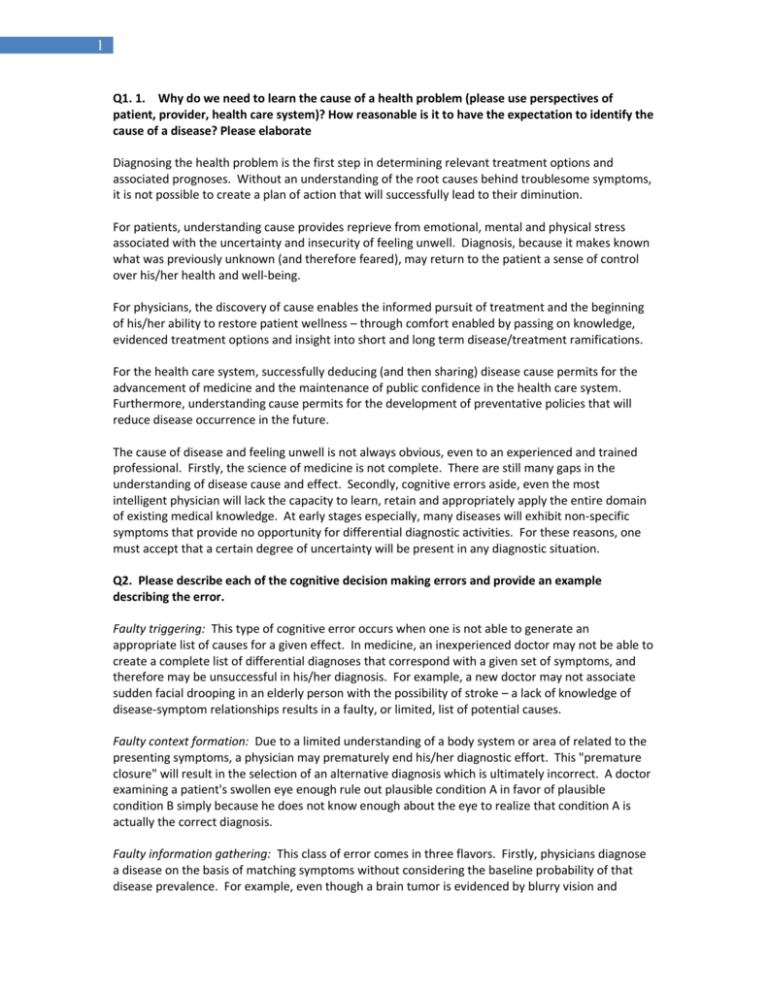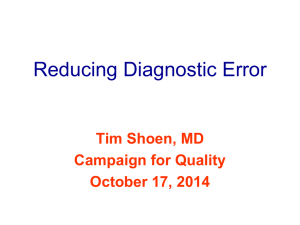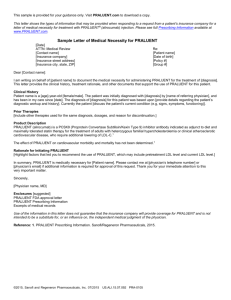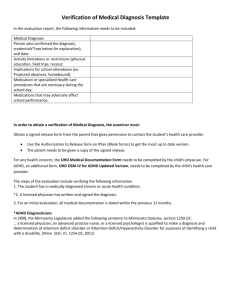HINF 351: Assignment #2
advertisement

1 Q1. 1. Why do we need to learn the cause of a health problem (please use perspectives of patient, provider, health care system)? How reasonable is it to have the expectation to identify the cause of a disease? Please elaborate Diagnosing the health problem is the first step in determining relevant treatment options and associated prognoses. Without an understanding of the root causes behind troublesome symptoms, it is not possible to create a plan of action that will successfully lead to their diminution. For patients, understanding cause provides reprieve from emotional, mental and physical stress associated with the uncertainty and insecurity of feeling unwell. Diagnosis, because it makes known what was previously unknown (and therefore feared), may return to the patient a sense of control over his/her health and well-being. For physicians, the discovery of cause enables the informed pursuit of treatment and the beginning of his/her ability to restore patient wellness – through comfort enabled by passing on knowledge, evidenced treatment options and insight into short and long term disease/treatment ramifications. For the health care system, successfully deducing (and then sharing) disease cause permits for the advancement of medicine and the maintenance of public confidence in the health care system. Furthermore, understanding cause permits for the development of preventative policies that will reduce disease occurrence in the future. The cause of disease and feeling unwell is not always obvious, even to an experienced and trained professional. Firstly, the science of medicine is not complete. There are still many gaps in the understanding of disease cause and effect. Secondly, cognitive errors aside, even the most intelligent physician will lack the capacity to learn, retain and appropriately apply the entire domain of existing medical knowledge. At early stages especially, many diseases will exhibit non-specific symptoms that provide no opportunity for differential diagnostic activities. For these reasons, one must accept that a certain degree of uncertainty will be present in any diagnostic situation. Q2. Please describe each of the cognitive decision making errors and provide an example describing the error. Faulty triggering: This type of cognitive error occurs when one is not able to generate an appropriate list of causes for a given effect. In medicine, an inexperienced doctor may not be able to create a complete list of differential diagnoses that correspond with a given set of symptoms, and therefore may be unsuccessful in his/her diagnosis. For example, a new doctor may not associate sudden facial drooping in an elderly person with the possibility of stroke – a lack of knowledge of disease-symptom relationships results in a faulty, or limited, list of potential causes. Faulty context formation: Due to a limited understanding of a body system or area of related to the presenting symptoms, a physician may prematurely end his/her diagnostic effort. This "premature closure" will result in the selection of an alternative diagnosis which is ultimately incorrect. A doctor examining a patient's swollen eye enough rule out plausible condition A in favor of plausible condition B simply because he does not know enough about the eye to realize that condition A is actually the correct diagnosis. Faulty information gathering: This class of error comes in three flavors. Firstly, physicians diagnose a disease on the basis of matching symptoms without considering the baseline probability of that disease prevalence. For example, even though a brain tumor is evidenced by blurry vision and 2 nausea, the chances of a young person exhibiting these symptoms actually having a brain tumor are very small and therefore it would be prudent for the physician to consider more likely diagnoses. Secondly, physicians have a hard time identifying the optimal differentiating information or information gathering strategies to assist them in making correct diagnoses. For example, new physicians will order too many tests, become overwhelmed with the resultant information, incorrectly identify certain results as especially significant, and then continue to pursue an incorrect diagnosis. Thirdly, physicians may rely too heavily on the use of heuristics and will forgo more conclusive tests before issuing a diagnosis. For example, if a college age male visits a clinic complaining of a burning sensation while urinating, he may quickly receive a diagnosis of gonorrhea from the physician (who is employing a common heuristic) without undergoing any tests which might more accurately identify a urinary tract infection. Faulty verification: When a physician settles on a diagnosis that matches the symptom set, but is not exclusive to that symptom set, he/she commits an error of faulty verification. While lethargy and fatigue are symptoms of depression, they are also symptomatic of other conditions, so a diagnosis of depression on these symptoms alone would be an error of faulty verification. 'No Fault' Errors: These errors occur when an extremely rare condition presents itself to a doctor, and the doctor could not have been reasonably expected to uncover the correct diagnosis using proper clinical reasoning or evidence. A child who falls in the playground and complains of a sore back to a physician will likely elude diagnosis of early stage leukemia - the condition is simply to rare, and the symptoms so general that no physician could reasonably identify the occult disease. Q3. Please analyze the cases provided, and explain which cognitive diagnostic decision making errors occurred in Nathan's and Blanche's cases. In Nathan's case, the physician made a "no-fault" error. Although the physician exercised sound clinical judgement and went out of his way to generate differential diagnoses, the exceptionally rare nature of the condition and the banality of the symptoms present at its early stage made the correct diagnosis too elusive - even to clinician specialists with advanced knowledge and experience. If any error was made, it was succumbing to the dismissive heuristic of the specialist. However, in 99% of the cases the specialist would be correct. In Blanche's case, the physician made a few cognitive errors. First of all, his awareness of the presence of pneumonia in the community biased his diagnostic efforts in the direction of pneumonia. In this way, you could say that he misapplied a heuristic that was based on situational knowledge. The misapplied heuristic resulted in a "premature closure" of his diagnostic effort - an error of faulty context formation which prevented him from pursuing other diagnostic avenues. Finally, through an error of faulty verification, he settled on a diagnosis that matched, but not exclusively so, to the presenting symptom set. Q4. One of the reasons of diagnostic error is information overload, what can information technology do to reduce the errors? Well designed and usable point of care clinical information systems can reduce errors from information overload in many ways. Firstly, well designed interfaces present information in ways 3 that make it easy to comprehend, manipulate and ultimately act on. Secondly, information technologies can provide means with which to filter information so that only the most recent, relevant, or trustworthy sources are presented. Thirdly, information technology can perform complex data analysis to identify trends and patterns within large information pools that could better inform decision making processes and prevent errors. Fourthly, information systems can alert clinicians to important events and data so that clinicians maintain a sense of priority in saturated information environments. In general, well designed information technologies increase the signalto-noise ratio of information needed for error-free point of care actions.






